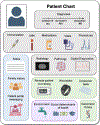Opportunities and challenges for biomarker discovery using electronic health record data
- PMID: 37474378
- PMCID: PMC10530198
- DOI: 10.1016/j.molmed.2023.06.006
Opportunities and challenges for biomarker discovery using electronic health record data
Abstract
Electronic health records (EHRs) have become increasingly relied upon as a source for biomedical research. One important research application of EHRs is the identification of biomarkers associated with specific patient states, especially within complex conditions. However, using EHRs for biomarker identification can be challenging because the EHR was not designed with research as the primary focus. Despite this challenge, the EHR offers huge potential for biomarker discovery research to transform our understanding of disease etiology and treatment and generate biological insights informing precision medicine initiatives. This review paper provides an in-depth analysis of how EHR data is currently used for phenotyping and identifying molecular biomarkers, current challenges and limitations, and strategies we can take to mitigate challenges going forward.
Keywords: biomarker discovery; electronic health records; phenotyping; precision medicine.
Copyright © 2023 Elsevier Ltd. All rights reserved.
Conflict of interest statement
Declaration of interests No interests are declared.
Figures


References
-
- Forrey AW et al. (1996) Logical observation identifier names and codes (LOINC) database: a public use set of codes and names for electronic reporting of clinical laboratory test results. Clin. Chem 42, 81–90 - PubMed
Publication types
MeSH terms
Substances
Grants and funding
LinkOut - more resources
Full Text Sources

